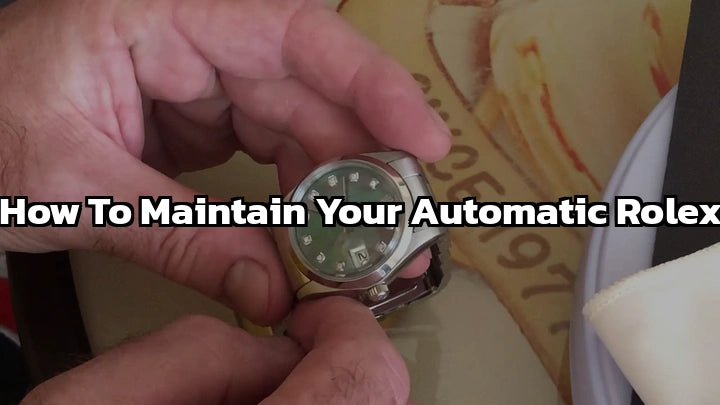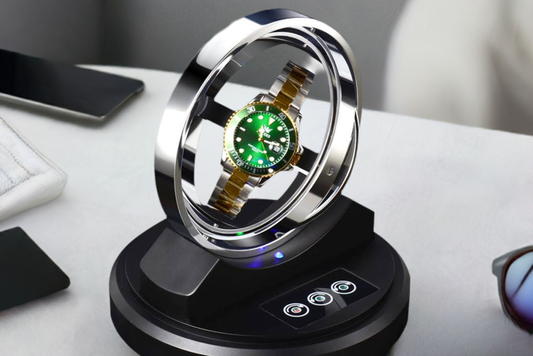Discover the art of maintaining your Automatic Rolex, ensuring it runs smoothly for years. Learn the precise techniques for winding, setting, and caring for your timepiece, addressing the nuances of automatic charging and debunking misconceptions around "recharging."
Understanding Automatic Watches
How Automatic Watches Work
Automatic watches, also known as self-winding watches, are mechanical timepieces that harness the kinetic energy generated by the wearer's movements to power the watch. This innovative technology eliminates the need for battery replacements, making these watches a popular choice among watch enthusiasts. The inner mechanics of an automatic watch are fascinating and complex, involving a series of intricate components that work in harmony to keep the watch running.
At the heart of an automatic watch is the rotor, a half-moon-shaped weight that oscillates with the wearer's movements. As the rotor rotates, it winds the mainspring, which stores energy that is then transmitted to the gear train. The gear train is a system of interlocking gears that transmits the power to the escapement, a mechanism that releases the stored energy in a controlled manner, allowing the watch's hands to move accurately. This process is known as the "power reserve," and it determines how long the watch will continue to run when not worn. On average, an automatic watch can store enough energy to power it for 36 to 40 hours, although some high-end models can last up to several days.
Rolex's Perpetual Movement
Rolex, a pioneer in watchmaking, has been at the forefront of automatic watch technology for decades. The company's Oyster Perpetual movement is a testament to its commitment to innovation and excellence. The Oyster Perpetual movement was first introduced in the 1930s and has since become a hallmark of Rolex watches.
The Oyster Perpetual movement is based on a self-winding mechanism that harnesses the wearer's movements to wind the mainspring. This mechanism is designed to provide a consistent and reliable power source, ensuring that the watch remains accurate and functional. Rolex's Perpetual movement is also equipped with a free-sprung balance wheel, which helps to regulate the watch's timekeeping. This balance wheel is designed to oscillate at a frequency of 28,800 vibrations per hour, providing an exceptional level of accuracy.
Rolex's Perpetual movement has undergone numerous improvements over the years, with the company continuously refining its design and materials to enhance performance and durability. Today, Rolex's Perpetual movement is considered one of the most reliable and accurate automatic movements in the world, with many Rolex watches boasting an accuracy of -2/+2 seconds per day.
The Oyster Perpetual movement is used in a range of Rolex models, including the iconic Datejust and Day-Date watches. These watches are known for their sleek designs, exceptional craftsmanship, and unparalleled performance. The Datejust, for example, features a 41mm case size and is available in a variety of materials, including stainless steel, gold, and two-tone. The Day-Date, on the other hand, boasts a 40mm case size and is available in gold or platinum.
Credit: YouTube Channel - The Honest Watch Dealer
Winding Your Rolex for Optimal Performance
Initial Winding
When it comes to winding your Rolex watch, the initial winding is crucial to ensure optimal performance. To properly wind your Rolex, follow these detailed steps:
-
Hold the watch correctly: Hold the watch in your non-dominant hand, with the crown facing upwards. Make sure your hand is steady and firm to avoid any accidental movements that might damage the watch.
-
Locate the crown: Identify the crown, which is typically located on the right side of the watch. The crown is used to wind the watch, set the time, and sometimes even adjust the date.
-
Pull out the crown: Gently pull the crown out to the first position. You will feel a slight click as it moves into place. In this position, you can wind the watch.
-
Wind the watch: Begin winding the watch by rotating the crown clockwise. It is recommended to perform 30-40 full rotations to fully wind the watch. This will ensure that the mainspring is fully charged, providing the optimal power reserve for your Rolex.
-
Check the power reserve: After winding, push the crown back to its original position. Check the power reserve indicator, if your Rolex model has one, to ensure it is fully charged.
Daily Wear and Charging
Your daily activity level plays a significant role in keeping your Rolex watch wound and charged. Here's how your daily activities affect the watch's winding and how to ensure it stays charged:
Understanding the self-winding mechanism: Rolex watches use a self-winding mechanism, also known as a rotor, which harnesses the wearer's movements to wind the watch. The rotor is connected to the mainspring, which stores energy as the watch is worn.
Activity level and winding: The amount of movement you engage in daily affects how well the watch winds. For example:
- Sedentary activities: If you have a desk job or engage in minimal physical activity, your watch may not wind as much, requiring more manual winding.
- Moderate activities: Engaging in moderate physical activities like walking or light exercise can provide sufficient winding.
- High-intensity activities: Participating in high-intensity activities like running or sports can wind the watch more efficiently.
Tips for optimal winding:
- Wear the watch regularly: Consistently wearing the watch helps maintain a consistent power reserve.
- Avoid extreme temperatures: Extreme temperatures can affect the watch's performance and winding efficiency.
- Store the watch properly: When not in use, store the watch in a cool, dry place, away from direct sunlight.
By following these steps and considering your daily activity level, you can ensure your Rolex watch remains wound and charged for optimal performance.
Setting the Date and Time on Your Rolex: A Comprehensive Step-by-Step Guide
As a proud owner of a Rolex watch, you understand the importance of maintaining its precision and functionality. One crucial aspect of owning a Rolex is setting the date and time correctly. This process may seem daunting, especially if you're new to automatic watches, but fear not! With this detailed guide, you'll learn how to unscrew the crown, set the time, and adjust the date without damaging your valuable timepiece.
Step 1: Prepare Your Watch
Before you begin, ensure your Rolex is in a stable and secure position. Place the watch on a soft, flat surface, away from any distractions or potential hazards. Take a moment to appreciate the intricate craftsmanship and attention to detail that goes into each Rolex timepiece. This will help you develop a deeper connection with your watch and make the process more enjoyable.
Step 2: Identify the Crown
Locate the crown of your Rolex, typically positioned on the right side of the watch case. The crown is the small, rounded knob used to wind the watch, set the time, and adjust the date. Take note of the crown's position and the direction it needs to be turned. For most Rolex models, the crown has three distinct positions:
- Position 1: Fully screwed in, used for normal wear and to protect the watch from water and dust.
- Position 2: Pulled out to the first click, used for setting the date.
- Position 3: Pulled out to the second click, used for setting the time.
Step 3: Unscrew the Crown
To begin setting the time and date, you'll need to unscrew the crown. Hold the watch firmly and turn the crown counterclockwise until it stops. You may feel a slight resistance as the crown is released from its screwed-in position. Be cautious not to apply too much force, as this could damage the watch's internal mechanisms.
Step 4: Set the Date
With the crown in Position 2 (pulled out to the first click), turn the crown clockwise to advance the date. You'll notice the date changing on the watch's face. Continue turning the crown until you reach the correct date. For Rolex models with a quick-set date feature, such as the Submariner or Datejust, you can quickly advance the date by turning the crown in a clockwise direction.
Step 5: Set the Time
Once the date is set, pull the crown out to Position 3 (the second click). Turn the crown clockwise to advance the hour and minute hands. Make sure to set the time accurately, taking into account daylight saving time (DST) if applicable. For Rolex models with a hacking seconds feature, such as the Explorer or GMT-Master, the seconds hand will stop moving when the crown is pulled out to Position 3, allowing for precise time setting.
Step 6: Verify and Secure
Double-check that the time and date are correctly set. Once you're satisfied, push the crown back in to Position 1 (fully screwed in) to secure the watch and protect it from water and dust. Give the crown a gentle clockwise turn to ensure it's fully seated.
Additional Tips and Considerations
- When setting the time, make sure to account for the watch's 24-hour cycle. If you're setting the time during the night, ensure the hour hand is pointing to the correct hour on the 24-hour scale.
- For Rolex models with a moon phase or other complications, you may need to adjust these features separately. Consult your watch's user manual or contact a Rolex authorized dealer for guidance.
- To maintain your Rolex's accuracy, it's recommended to wind the watch regularly, especially if it's not worn frequently. This will help keep the watch's power reserve topped up and ensure optimal performance.
By following these detailed steps, you'll be able to set the date and time on your Rolex watch with confidence and precision. Remember to handle your watch with care, and it will continue to serve you faithfully for generations to come.
Rolex and Winders: When and Why to Use an Automatic Watch Winder
When it comes to maintaining the precision and longevity of your Rolex automatic watch, using an automatic watch winder can be a valuable investment. These devices are designed to keep your watch wound and ready to wear, even when it's not on your wrist. But when exactly should you use an automatic watch winder, and what are the recommended settings for optimal storage?
Automatic watches, like Rolex, rely on the wearer's movements to wind the mainspring, which powers the watch's mechanisms. However, if you don't wear your Rolex regularly, the mainspring can unwind, causing the watch to stop functioning. This is where an automatic watch winder comes in. By mimicking the natural movements of the wearer's wrist, the winder winds the watch, ensuring it remains accurate and functional.
There are several scenarios where using an automatic watch winder is particularly beneficial. For instance, if you have a large collection of Rolex watches and can't wear them all regularly, a winder can help keep them wound and ready for use. Additionally, if you plan to store your Rolex for an extended period, a winder can help maintain the watch's accuracy and prevent damage to the mechanisms.
When selecting the right winder for your Rolex, it's essential to consider the watch's specific requirements. Rolex recommends that their automatic watches be wound to a minimum of 80% of their maximum power reserve to ensure optimal performance. Therefore, it's crucial to choose a winder that can accommodate this requirement.
Recommended Settings for Optimal Storage
To get the most out of your automatic watch winder, it's essential to set it correctly. Here are some recommended settings to consider:
- Direction of Rotation: Most Rolex automatic watches wind in a clockwise direction. Ensure your winder is set to rotate in this direction to avoid damaging the watch's mechanisms.
- Number of Turns Per Day (TPD): The ideal TPD for a Rolex automatic watch varies depending on the model. For example, the Rolex Submariner requires around 650-800 TPD, while the Rolex Daytona needs approximately 800-1,000 TPD. Consult your watch's manual or contact a Rolex authorized dealer for specific guidance.
- Winding Mode: Some winders offer different winding modes, such as continuous, intermittent, or sleep mode. Choose a mode that suits your watch's needs and your storage plans.
- Winding Speed: The winding speed of your winder should be adjusted according to your watch's requirements. Faster winding speeds can be beneficial for watches with shorter power reserves, while slower speeds are more suitable for watches with longer power reserves.
Choosing the Right Winder for Your Rolex
With so many automatic watch winders available on the market, selecting the right one for your Rolex can be overwhelming. Here are some key factors to consider when making your decision:
- Watch Compatibility: Ensure the winder is compatible with your Rolex model. Some winders are designed specifically for certain watch brands or models, so it's crucial to check compatibility before making a purchase.
- Winding Mode and Speed: As mentioned earlier, the winding mode and speed of your winder should be tailored to your watch's requirements. Look for a winder that offers adjustable winding modes and speeds.
- Power Source: Winders can be powered by batteries, AC adapters, or both. Consider a winder with a battery backup in case of power outages.
- Construction and Quality: A high-quality winder with a sturdy construction will provide better protection for your watch. Look for winders made from durable materials, such as wood or metal.
- Additional Features: Some winders come with additional features, such as watch storage cases, travel cases, or smart technology integration. Consider what features are important to you and your watch collection.
Some popular automatic watch winders for Rolex include:
- Wolf 27002: A high-end winder with adjustable winding modes and speeds, suitable for most Rolex models. ($1,295)
- Orbita Sparta: A compact and affordable winder with a battery backup, ideal for smaller Rolex collections. ($195)
- Buben & Zorweg: A luxury winder with advanced features, such as smart technology integration and a built-in watch case. ($3,995)
By considering these factors and recommended settings, you can ensure your Rolex automatic watch remains accurate, functional, and well-maintained, even when not in use.
Myth: Recharging a Rolex
One of the most prevalent misconceptions surrounding Rolex watches is the need to "recharge" them. Many people believe that Rolex watches, particularly those with automatic movements, require periodic recharging to maintain their power reserve. However, this is a common myth that needs to be debunked.
Rolex watches, specifically those with automatic movements, do not need to be recharged. Instead, they are self-winding, meaning they harness the wearer's movements to generate power. This is achieved through the oscillating rotor, which converts the wearer's movements into mechanical energy that powers the watch. As long as the watch is worn regularly, the rotor will continue to wind the mainspring, maintaining the power reserve.
In fact, Rolex's patented Perpetual rotor, introduced in the 1930s, revolutionized the watchmaking industry by allowing for a self-winding mechanism that eliminates the need for battery replacements or recharging. This innovative technology has been refined over the years, ensuring that Rolex watches remain accurate and reliable without the need for external power sources.
It's essential to understand that Rolex watches do require regular maintenance to ensure optimal performance. This includes having the watch serviced every 5-10 years, depending on usage, to clean and lubricate the movement, as well as replace worn-out parts. However, this maintenance is not equivalent to recharging, as it does not involve replenishing a power source.
Waterproofing and Maintenance
Another crucial aspect of Rolex watch ownership is maintaining the waterproof seals to ensure the watch's longevity. Rolex watches are renowned for their exceptional water resistance, with some models capable of withstanding depths of up to 3,900 meters (12,800 feet). However, this water resistance is not indefinite and requires regular maintenance to ensure the seals remain intact.
To maintain the waterproof seals, it's essential to:
- Avoid exposing the watch to sudden changes in temperature or pressure, as this can cause the seals to expand or contract, potentially compromising their integrity.
- Regularly inspect the watch for signs of wear or damage, such as scratches or cracks on the case, crystal, or seals. If any damage is detected, it's crucial to have the watch serviced promptly to prevent water ingress.
- Have the watch serviced every 5-10 years, depending on usage, to inspect and replace worn-out seals, as well as clean and lubricate the movement.
- Avoid using harsh chemicals or cleaning products, which can damage the seals or other components. Instead, use a soft, dry cloth to wipe down the watch.
When servicing your Rolex, it's vital to choose an authorized Rolex dealer or a reputable independent watchmaker. They will have the necessary expertise and genuine Rolex parts to ensure that your watch is properly maintained and restored to its original condition.
In conclusion, understanding the self-winding mechanism of Rolex watches and maintaining the waterproof seals are crucial aspects of owning a Rolex. By debunking common misconceptions and following proper maintenance procedures, you can ensure that your Rolex watch remains accurate, reliable, and functional for generations to come.




